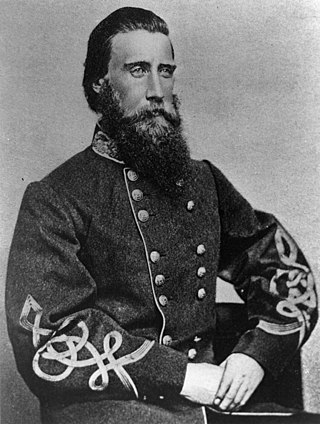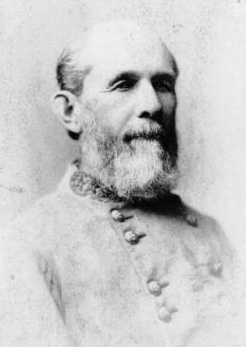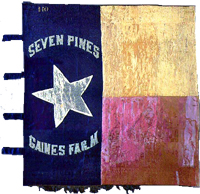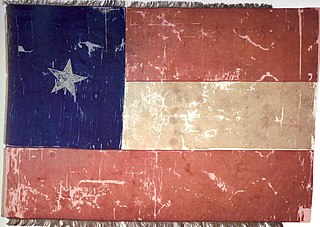
The Second Battle of Bull Run or Battle of Second Manassas was fought August 28–30, 1862, in Prince William County, Virginia, as part of the American Civil War. It was the culmination of the Northern Virginia Campaign waged by Confederate Gen. Robert E. Lee's Army of Northern Virginia against Union Maj. Gen. John Pope's Army of Virginia, and a battle of much larger scale and numbers than the First Battle of Bull Run fought on July 21, 1861, on the same ground.

Trinity County is a county located in the U.S. state of Texas. As of the 2020 census, the population was 13,602. Its county seat is Groveton. The county is named for the Trinity River.

John Bell Hood was a Confederate general during the American Civil War. Hood's impetuosity led to high losses among his troops as he moved up in rank. Bruce Catton wrote that "the decision to replace Johnston with Hood was probably the single largest mistake that either government made during the war." Hood's education at the United States Military Academy led to a career as a junior officer in the infantry and cavalry of the antebellum U.S. Army in California and Texas. At the start of the Civil War, he offered his services to his adopted state of Texas. He achieved his reputation for aggressive leadership as a brigade commander in the army of Robert E. Lee during the Seven Days Battles in 1862, after which he was promoted to division command. He led a division under James Longstreet in the campaigns of 1862–63. At the Battle of Gettysburg, he was severely wounded, rendering his left arm mostly useless for the rest of his life. Transferred with many of Longstreet's troops to the Western Theater, Hood led a massive assault into a gap in the U.S. line at the Battle of Chickamauga but was wounded again, requiring the amputation of his right leg.

John Charles Black was a Democratic U.S. Congressman from Illinois. He received the Medal of Honor for his actions as a Union Army lieutenant colonel and regimental commander at the Battle of Prairie Grove during the American Civil War.

John Gregg was an American politician who served as a deputy from Texas to the Provisional Congress of the Confederate States from 1861 to 1862. He served as a brigade commander officer of the Confederate States Army and was killed in action during the Siege of Petersburg.
The Battle of Old Fort Wayne, also known as Maysville, Beattie's Prairie, or Beaty's Prairie, was an American Civil War battle on October 22, 1862, in Delaware County in what is now eastern Oklahoma.

William Tatum Wofford was an officer during the Mexican–American War and a general in the Confederate States Army during the American Civil War.
The 34th Indiana Veteran Volunteer Infantry Regiment, nicknamed The Morton Rifles, was an Infantry Regiment that served in the Union Army during the American Civil War. It had the distinction of fighting in the last land action of the war, the Battle of Palmito Ranch, Texas May 12–13, 1865, and also of suffering the last soldier killed during the war, Private John J. Williams.

Jerome Bonaparte Robertson was a doctor, Indian fighter, Texas politician, and a general in the Confederate States Army during the American Civil War. He was noted for his service in the famed Texas Brigade in the Army of Northern Virginia.
Centralia is an unincorporated community in Trinity County, Texas, United States. In 2000, the estimated population was 53 residents. It is located within the Huntsville, Texas micropolitan area.
Nogalus Prairie is an unincorporated community in Trinity County, Texas, United States. In 2000, the estimated population was 109 residents. It is located within the Huntsville, Texas micropolitan area.

Hamilton Prioleau Bee was an American politician in early Texas; he was secretary of the Texas Senate in 1846. He served nearly 10 years as representative to the state house beginning in 1849, and for one term as Speaker of the Texas House of Representatives.

Hiram Bronson Granbury was a lawyer and county judge in Texas before the American Civil War. He organized a volunteer company for the Confederate States Army after the outbreak of the Civil War and became its captain. He rose to the grade of brigadier general in the Confederate army. Granbury was one of the six Confederate generals killed at the Battle of Franklin on November 30, 1864.

William Plummer Benton was an American lawyer and soldier who served in both the Mexican–American War and the American Civil War, where he would rise to the rank of brigadier general and, in 1866, after his service had ended, would be awarded the brevet grade of major general.
Sion Record Bostick was a soldier for the Texas Army during the Texas Revolution, and later fought for the Confederate States Army during the American Civil War. Bostick is most famous as one of the Texas Army scouts who captured Antonio López de Santa Anna during the Texas Revolution.

The 1st Texas Infantry Regiment, nicknamed the "Ragged Old First," was an infantry regiment raised in Texas for service in the Confederate States Army during the American Civil War. It fought mostly with the Army of Northern Virginia.
The 46th Regiment Indiana Infantry was a regiment of the Union Army during the American Civil War.

The 27th Arkansas Infantry Regiment (1862–1865) was a Confederate Army infantry regiment during the American Civil War. The unit served entirely in the Department of the Trans-Mississippi and surrendered at Marshall, Texas, at the war's end.

The 5th Texas Infantry Regiment was a unit of Confederate States Army infantry volunteers created in 1861 that fought in the Army of Northern Virginia during the American Civil War. The unit was part of the famous Texas Brigade. The regiment fought at Eltham's Landing, Seven Pines, Gaines's Mill, Second Bull Run, South Mountain, Antietam, and Fredericksburg in 1862. It fought at Gettysburg and Chickamauga in 1863 and the Wilderness, Spotsylvania, Cold Harbor, and the Siege of Petersburg in 1864. The regiment surrendered to Federal forces on 9 April 1865 after the Battle of Appomattox Court House.













